INTERVAL FINITE
ELEMENT METHOD
WITH MATLAB®
�
INTERVAL FINITE
ELEMENT METHOD
WITH MATLAB®
SUKANTA NAYAK
SNEHASHISH CHAKRAVERTY
�
Academic Press is an imprint of Elsevier
125 London Wall, London EC2Y 5AS, United Kingdom
525 B Street, Suite 1800, San Diego, CA 92101-4495, United States
50 Hampshire Street, 5th Floor, Cambridge, MA 02139, United States
The Boulevard, Langford Lane, Kidlington, Oxford OX5 1GB, United Kingdom
© 2018 Elsevier Inc. All rights reserved.
No part of this publication may be reproduced or transmitted in any form or by any means, electronic
or mechanical, including photocopying, recording, or any information storage and retrieval system,
without permission in writing from the publisher. Details on how to seek permission, further
information about the Publisher’s permissions policies and our arrangements with organizations such as
the Copyright Clearance Center and the Copyright Licensing Agency, can be found at our website:
www.elsevier.com/permissions.
This book and the individual contributions contained in it are protected under copyright by the Publisher
(other than as may be noted herein).
Notices
Knowledge and best practice in this field are constantly changing. As new research and experience
broaden our understanding, changes in research methods, professional practices, or medical treatment
may become necessary.
Practitioners and researchers must always rely on their own experience and knowledge in evaluating
and using any information, methods, compounds, or experiments described herein. In using such
information or methods they should be mindful of their own safety and the safety of others,
including parties for whom they have a professional responsibility.
To the fullest extent of the law, neither the Publisher nor the authors, contributors, or editors,
assume any liability for any injury and/or damage to persons or property as a matter of products liability,
negligence or otherwise, or from any use or operation of any methods, products, instructions, or
ideas contained in the material herein.
Library of Congress Cataloging-in-Publication Data
A catalog record for this book is available from the Library of Congress
British Library Cataloguing-in-Publication Data
A catalogue record for this book is available from the British Library
ISBN 978-0-12-812973-9
For information on all Academic Press publications visit our
website at https://www.elsevier.com/books-and-journals
Publisher: Matthew Deans
Acquisition Editor: Brian Guerin
Editorial Project Manager: Katie Chan
Production Project Manager: Anusha Sambamoorthy
Cover Designer: Greg Harris
Typeset by SPi Global, India
�
AUTHOR BIOGRAPHIES
Dr. Sukanta Nayak is an assistant professor of mathematics at Amrita
Vishwa Vidyapeetham, Coimbatore. Prior to coming to Amrita Vishwa
Vidyapeetham, he was a postdoctoral research fellow at University of Johan-
nesburg, South Africa, from August 2016 to June 2017. He was a lecturer at
Veer Surendra Sai University of Technology, Burla, from January 2016 to
May 2016. He received Ph.D. in mathematics from National Institute of
Technology Rourkela in January 2016. He has received Global Excellence
Stature Postdoctoral Fellowship in 2016 and postgraduate scholarship from
Government of Odisha in 2008. In addition, he has qualified the all-India
Graduate Aptitude Test in Engineering (GATE) and was awarded “Best
Presentation” of Department of Mathematics at Research Scholar Week
(RSW-2015) NIT Rourkela in 2015. His research interests span both
uncertainty modeling and its engineering applications. He is also an author
of the book entitled Neutron Diffusion: Concepts and Uncertainty Analysis for
Engineers and Scientists of CRC Press (Taylor and Francis) and, until now,
he has published 11 peer-reviewed research articles and 2 book chapters
of international repute.
Dr. Snehashish Chakraverty is a professor of mathematics in National
Institute of Technology Rourkela, Odisha. He received Ph.D. from IIT
Roorkee in 1992. Then he did postdoctoral research at ISVR, University
of Southampton, United Kingdom, and at Concordia University, Canada.
He was a visiting professor at Concordia & McGill Universities, Canada, and
University of Johannesburg, South Africa also. Prof. Chakraverty has
authored 10 books and published around 275 research papers in journals
and conferences. He was President of the Section of Mathematical Sciences
(including Statistics) of Indian Science Congress (2015–16) and was the Vice
President—Orissa Mathematical Society (2011–13). Prof. Chakraverty is
recipient of a few prestigious awards, viz. INSA International Bilateral
Exchange Program, Platinum Jubilee ISCA Lecture, CSIR Young Scientist,
BOYSCAST, UCOST Young Scientist, Golden Jubilee CBRI Director’s
Award, Roorkee University gold Medals, etc. He has undertaken around
17 research projects as Principal Investigator funded by different agencies.
His present research area includes soft computing, numerical analysis, differ-
ential equations, mathematical modeling, vibration and inverse vibration
problems.
vii
�
PREFACE
Finite element method is a well-known and versatile numerical method that
is used to model and investigate various problems in different subject
areas. On the other hand, uncertainty plays an important role in real-world
problems. These uncertainties occurs due to the vague, imprecise, and
incomplete information about the variables and parameters being a result
of errors in measurement, observations, experiment, applying different
operating conditions, or it may be maintenance-induced errors, which
are uncertain in nature. To manage these uncertainties and vagueness,
one may use interval or stochastic environment in parameters and variables
in place of crisp (fixed) ones. However, probability theory requires sufficient
number of data, which are not possible in general. Therefore, instead of sto-
chastic, one may use intervals for the uncertain parameters and accordingly
the problem may be modeled. Hence, the governing differential equations
become interval. In order to investigate various uncertain practical prob-
lems, the concept of interval uncertainties may be hybridized with the finite
element method (FEM) to develop interval finite element method (IFEM).
As such, this book aims to provide a new direction for the reader to deal with
the uncertain problems by using IFEM. Various structural problems, viz.
spring mass, bar, truss, frame, etc., have been modeled here using IFEM
in uncertain (interval) environment. Further, a systematic approach with
®
respect to MATLAB
codes has been provided to study the mentioned
problems using IFEM.
The major essence of this book is to focus on uncertainties involved in
various simple structural problems along with their numerical solutions and
®
MATLAB
codes. This book includes a systematic procedure, and chapters
have been arranged in a sequence so that readers will follow it easily. Accord-
ingly, the first three chapters consist of basics of interval arithmetic, hybrid-
®
ization with FEM (i.e., IFEM) and that of MATLAB
preliminaries. Next
even-numbered chapters, viz. 4, 6, and 8, address the formulation of IFEM
for various easy-to-follow structural problems and the odd-numbered chap-
ters, viz. 5, 7, and 9, include the corresponding MATLAB
codes.
®
Let us elaborate few more details regarding the chapters now. As such,
Chapter 1 describes various terminologies of interval uncertainties and inter-
val arithmetic. In this chapter, a brief motivation of interval uncertainties has
been introduced to reflect a concise idea of intervals. Chapter 2 has been
ix
�
x
Preface
®
dedicated to understand IFEM for solving uncertain differential equations.
The involved parameters in the governing differential equations have been
considered as intervals and then general procedure is addressed to deduce
®
IFEM. Preliminaries of MATLAB
software, various syntax, commands,
and operators are included in Chapter 3. It also includes a systematic
®
approach to write the MATLAB
codes. Chapter 4 deals with one-
dimensional structural element formulations using IFEM. Considering
interval uncertainties, stiffness matrices and elemental equations of various
structural elements, viz. spring, bar, and quadratic bar elements, are devel-
oped. Chapter 5 presents IFEM MATLAB
functions for spring, bar, and
quadratic bar elements, and various example problems have been investi-
gated through the developed codes. Next,
formulation of IFEM for
two-dimensional structural elements, viz. plane truss, beam, plane frame,
and triangular elements, is given in Chapter 6. Taking interval uncertainties,
interval stiffness matrices and elemental equations are again formed for the
®
same. In Chapter 7, the MATLAB
codes for two-dimensional structural
elements as mentioned in Chapter 6 are developed. The developed codes
have been utilized to solve few example problems and corresponding results
are reported. Further, the formulations of IFEM for three-dimensional ele-
ments, viz. space truss, space frame, and linear tetrahedral elements, are
described in Chapter 8. Then, the interval element stiffness and elemental
equations are established. Finally in Chapter 9, MATLAB
IFEM codes
are developed for
elements mentioned in
Chapter 8, which are also illustrated through simple example problems.
three-dimensional
the
®
As regards, good FEM books as well as few books on interval computing
are certainly available. It may also be noted that interval finite element
method is becoming a challenging tool to handle the uncertain problems.
In this respect, various researchers throughout the globe have published
good and interesting papers. While working on this field, we thought of
having a book on this challenging area, which may help the students and
researchers for their academic and industrial endeavor. Accordingly, the
intended audience for this book must be the graduate, postgraduate, and
doctoral students along with teachers, engineers, and researchers who are
in need of handling the uncertain (interval) environment on different engi-
neering subjects like civil, mechanical, aerospace and in science areas such as
mathematics, applied and industrial mathematics, and physics. This book
will serve to understand the interval uncertainties caused due to the vague
or impreciseness,
finite element method, and corresponding
®
MATLAB
codes.
interval
�
Preface
xi
It is worth mentioning that very simple structural problems have been
considered here to have the first-hand knowledge about handling interval
®
uncertainties using IFEM. Interested readers may find the MATLAB
codes
very useful and fruitful because those are written in a very simple, systematic,
and easy-to-understand form. The authors do believe that this book will cer-
tainly ignite the users to write their own codes that may handle the related
problems.
Sukanta Nayak
Snehashish Chakraverty
�
ACKNOWLEDGMENTS
This book is the outcome of our last 7 years’ rigorous study and research in
the area of uncertainty modeling. The uncertainty issues are addressed here
®
through interval theory and then the interval finite element with MATLAB
codes is developed for first-hand use. We have been inspired from the work
of Dr. Peter Kattan and acknowledge him with high regard. The authors are
very much grateful to National Institute of Technology Rourkela, India,
and University of Johannesburg, South Africa, for giving a platform to ini-
tiate this work.
The first author expresses his gratitude to his father Mr. Hadibandhu
Nayak and mother Mrs. Shrimati Nayak who supported him in each step
of his life and have been a constant source of inspiration. Also, he would like
to thank his friend Peehu who encouraged him all the time. Finally, he is
very much grateful to those who have been with him over the course of
the years and both directly and indirectly helped him for the completion
of this book.
The second author would like to thank first his beloved parents. Next he
would like to thank his wife Mrs. Shewli Chakraborty and daughters
Shreyati and Susprihaa for their continuous love, support, and source of
inspiration at all the time during the preparation of this book.
We would like to express our sincere gratitude to the readers who will go
through this book and enjoy the beauty of interval finite element method
®
with MATLAB
for various structural problems. The contributors and
authors referred in this book are greatly appreciated. Finally, we would like
to thank the Academic Press for enabling us to publish this book and to the
team of the publisher who directly or indirectly provided us help and sup-
port throughout this project.
xiii
�

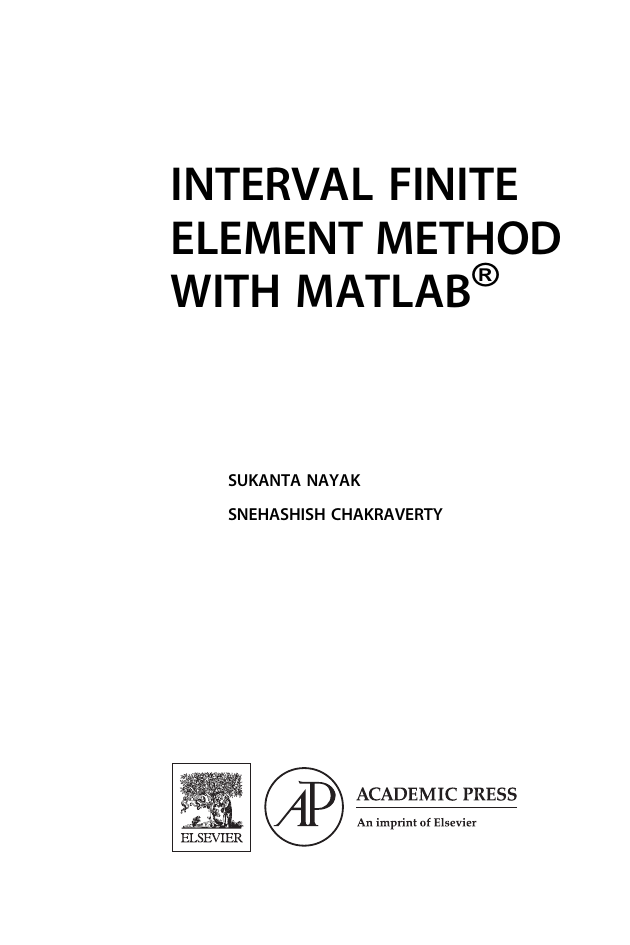
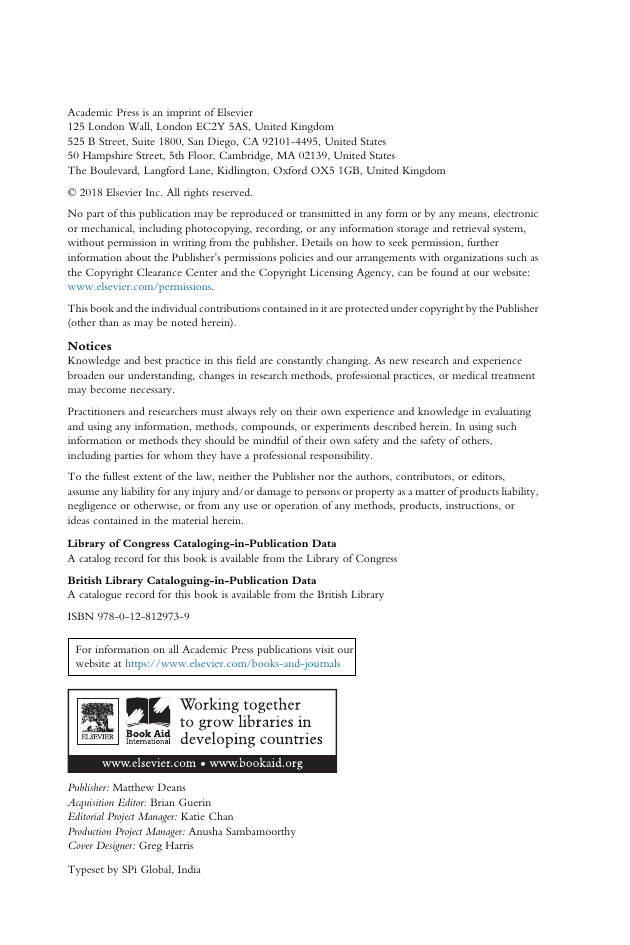
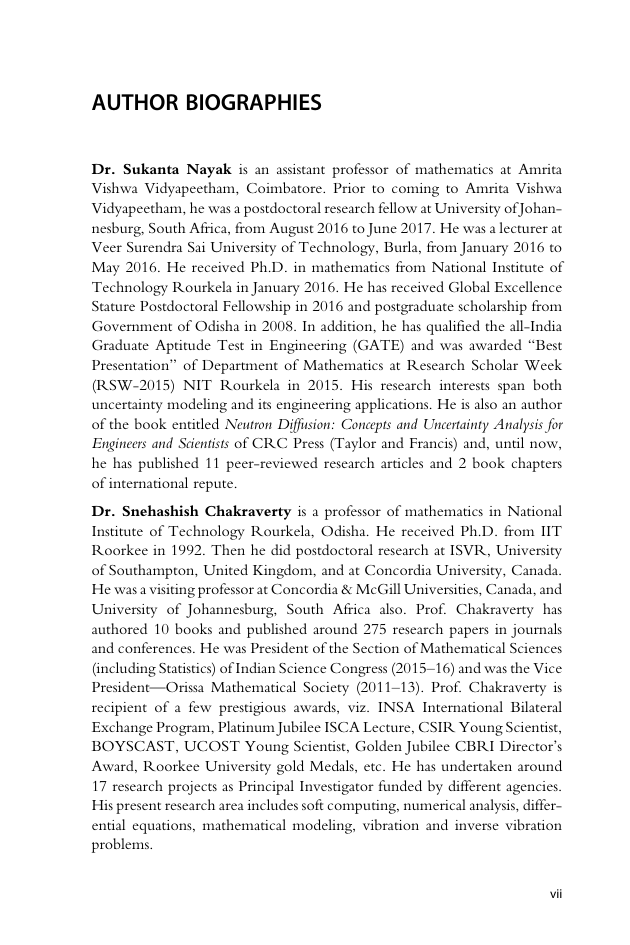
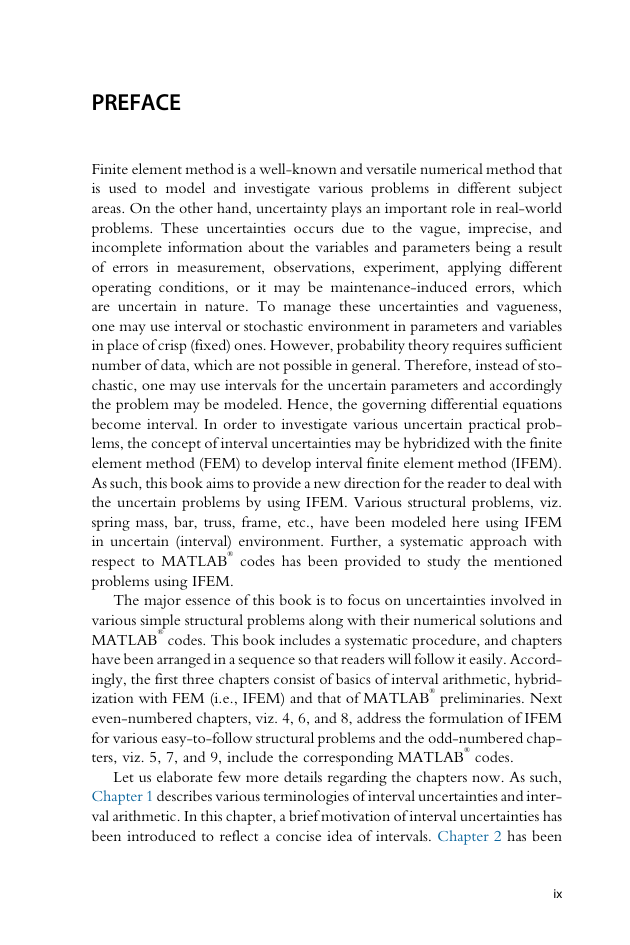
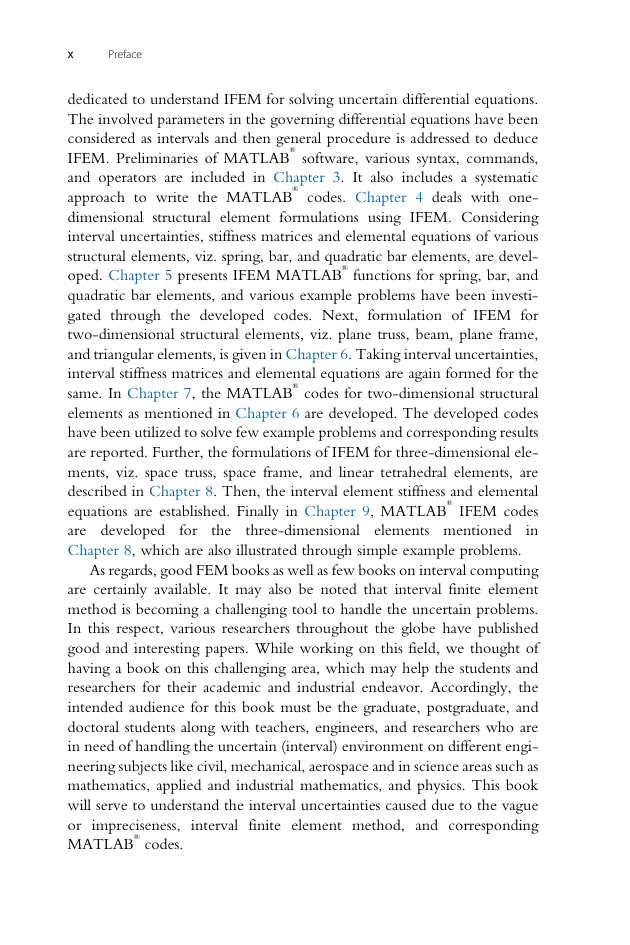
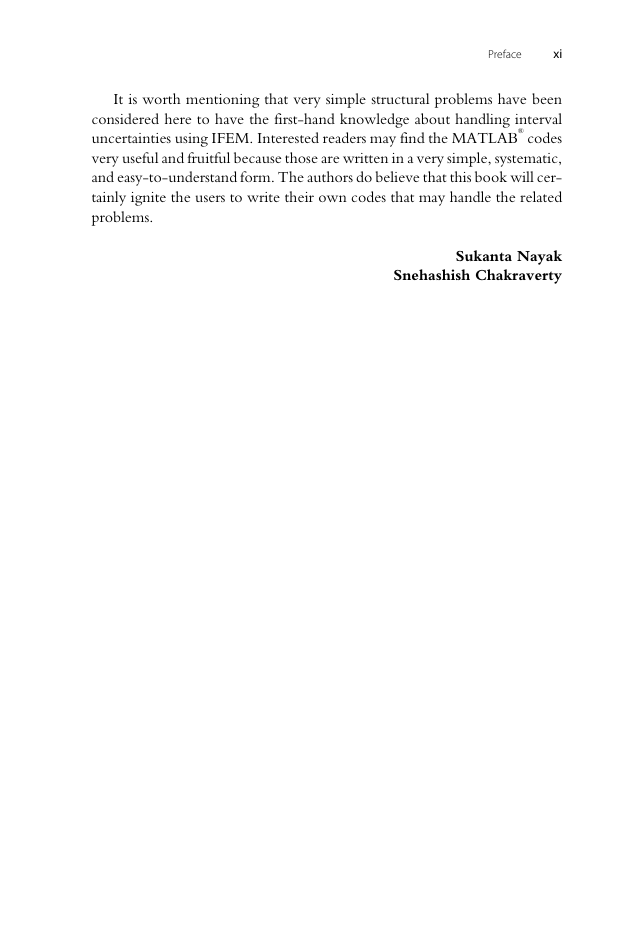









 2023年江西萍乡中考道德与法治真题及答案.doc
2023年江西萍乡中考道德与法治真题及答案.doc 2012年重庆南川中考生物真题及答案.doc
2012年重庆南川中考生物真题及答案.doc 2013年江西师范大学地理学综合及文艺理论基础考研真题.doc
2013年江西师范大学地理学综合及文艺理论基础考研真题.doc 2020年四川甘孜小升初语文真题及答案I卷.doc
2020年四川甘孜小升初语文真题及答案I卷.doc 2020年注册岩土工程师专业基础考试真题及答案.doc
2020年注册岩土工程师专业基础考试真题及答案.doc 2023-2024学年福建省厦门市九年级上学期数学月考试题及答案.doc
2023-2024学年福建省厦门市九年级上学期数学月考试题及答案.doc 2021-2022学年辽宁省沈阳市大东区九年级上学期语文期末试题及答案.doc
2021-2022学年辽宁省沈阳市大东区九年级上学期语文期末试题及答案.doc 2022-2023学年北京东城区初三第一学期物理期末试卷及答案.doc
2022-2023学年北京东城区初三第一学期物理期末试卷及答案.doc 2018上半年江西教师资格初中地理学科知识与教学能力真题及答案.doc
2018上半年江西教师资格初中地理学科知识与教学能力真题及答案.doc 2012年河北国家公务员申论考试真题及答案-省级.doc
2012年河北国家公务员申论考试真题及答案-省级.doc 2020-2021学年江苏省扬州市江都区邵樊片九年级上学期数学第一次质量检测试题及答案.doc
2020-2021学年江苏省扬州市江都区邵樊片九年级上学期数学第一次质量检测试题及答案.doc 2022下半年黑龙江教师资格证中学综合素质真题及答案.doc
2022下半年黑龙江教师资格证中学综合素质真题及答案.doc